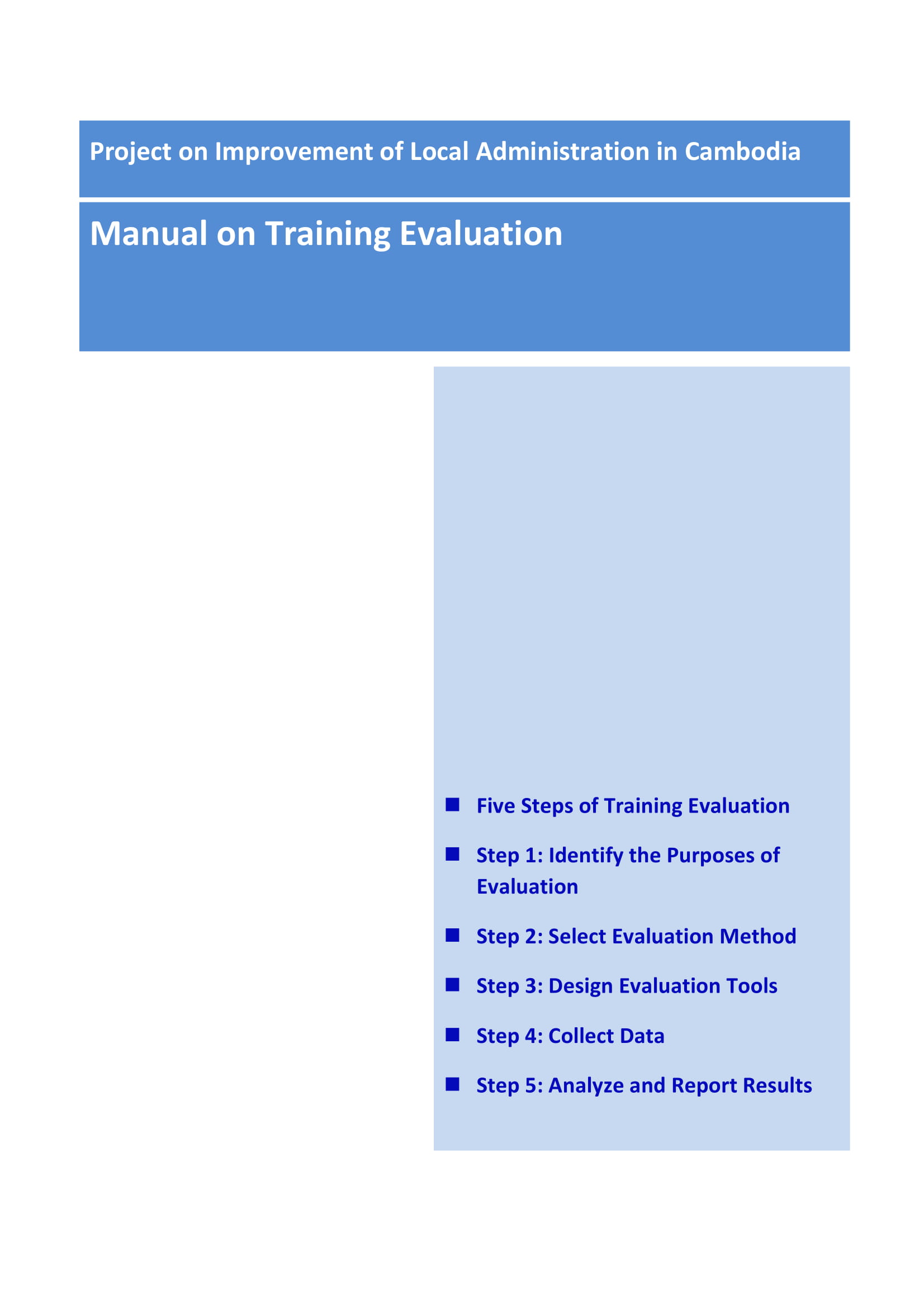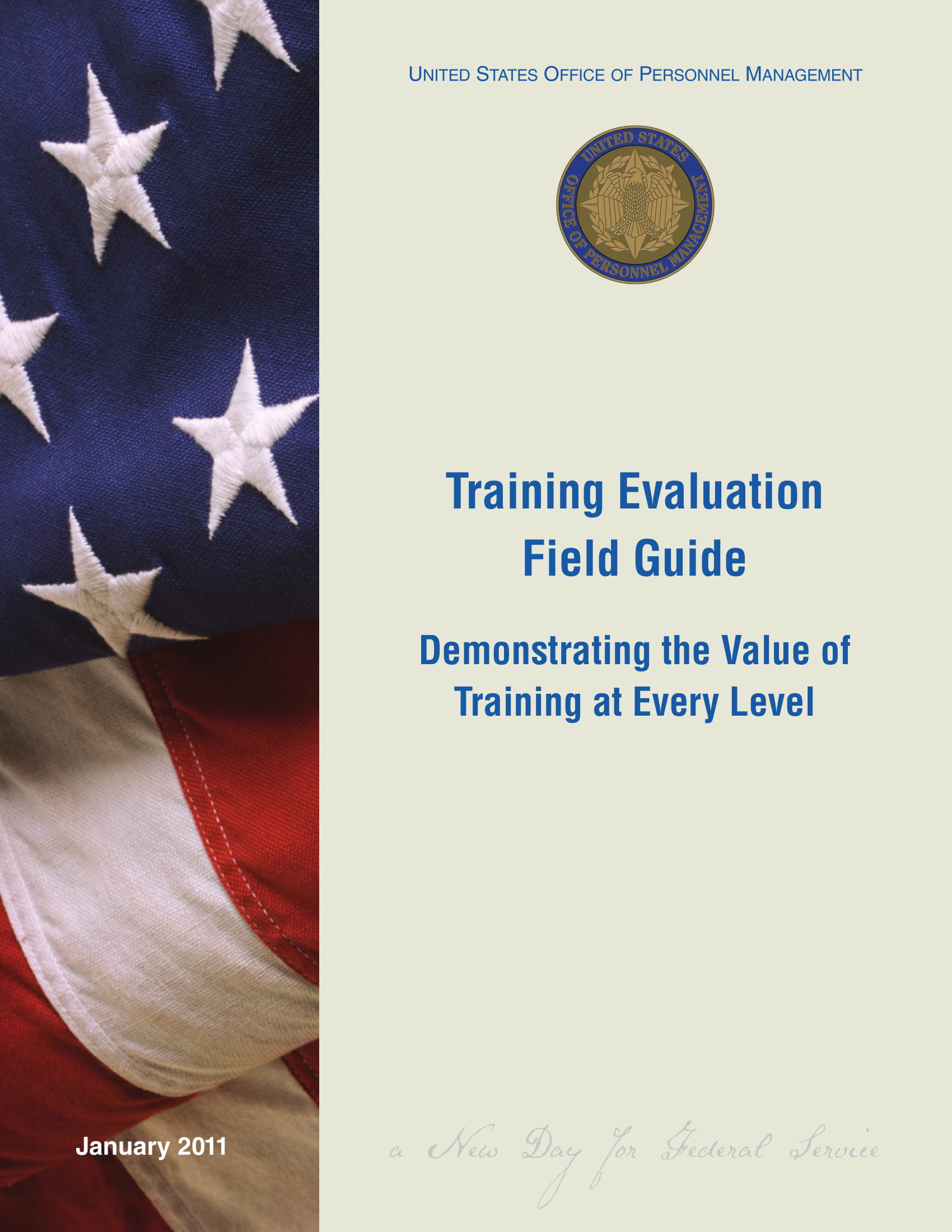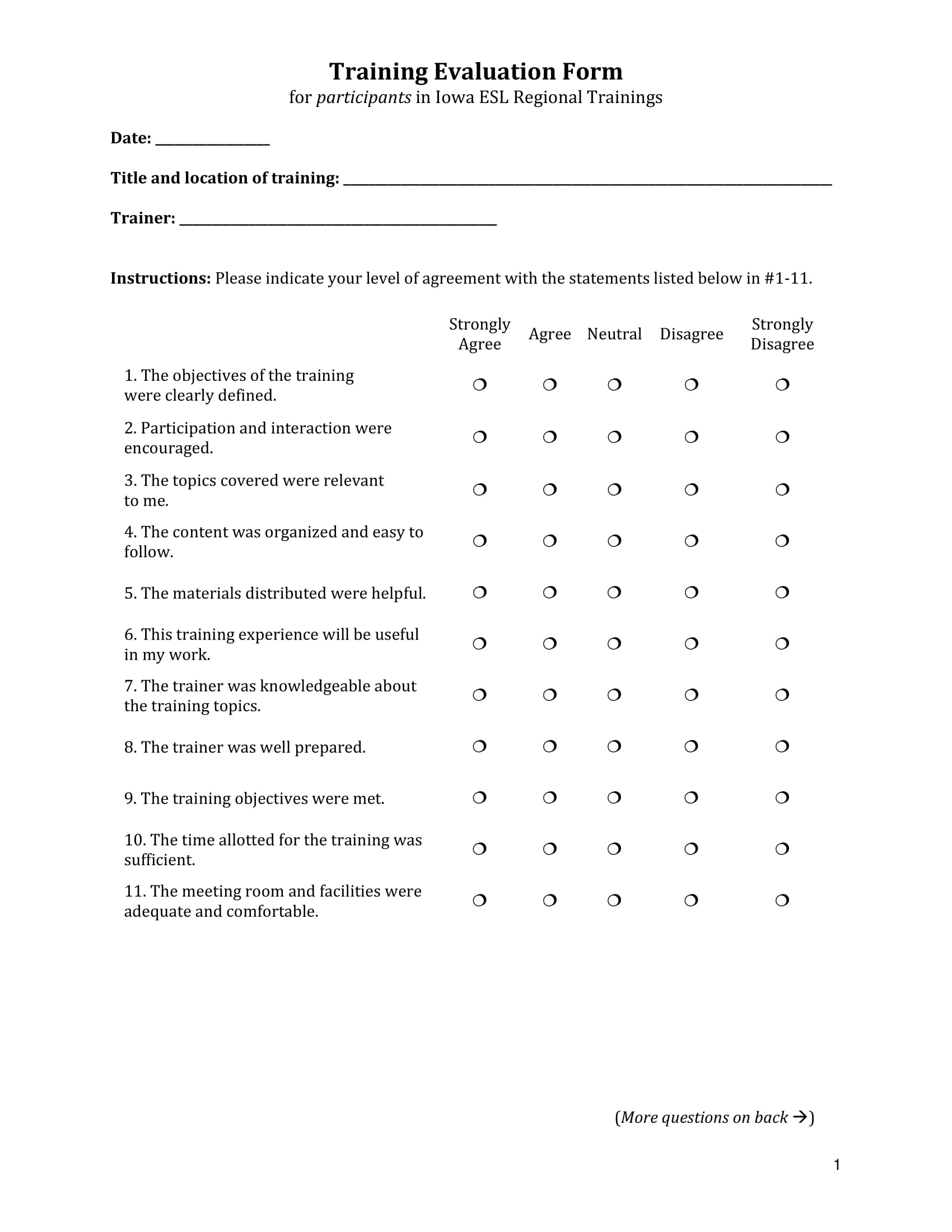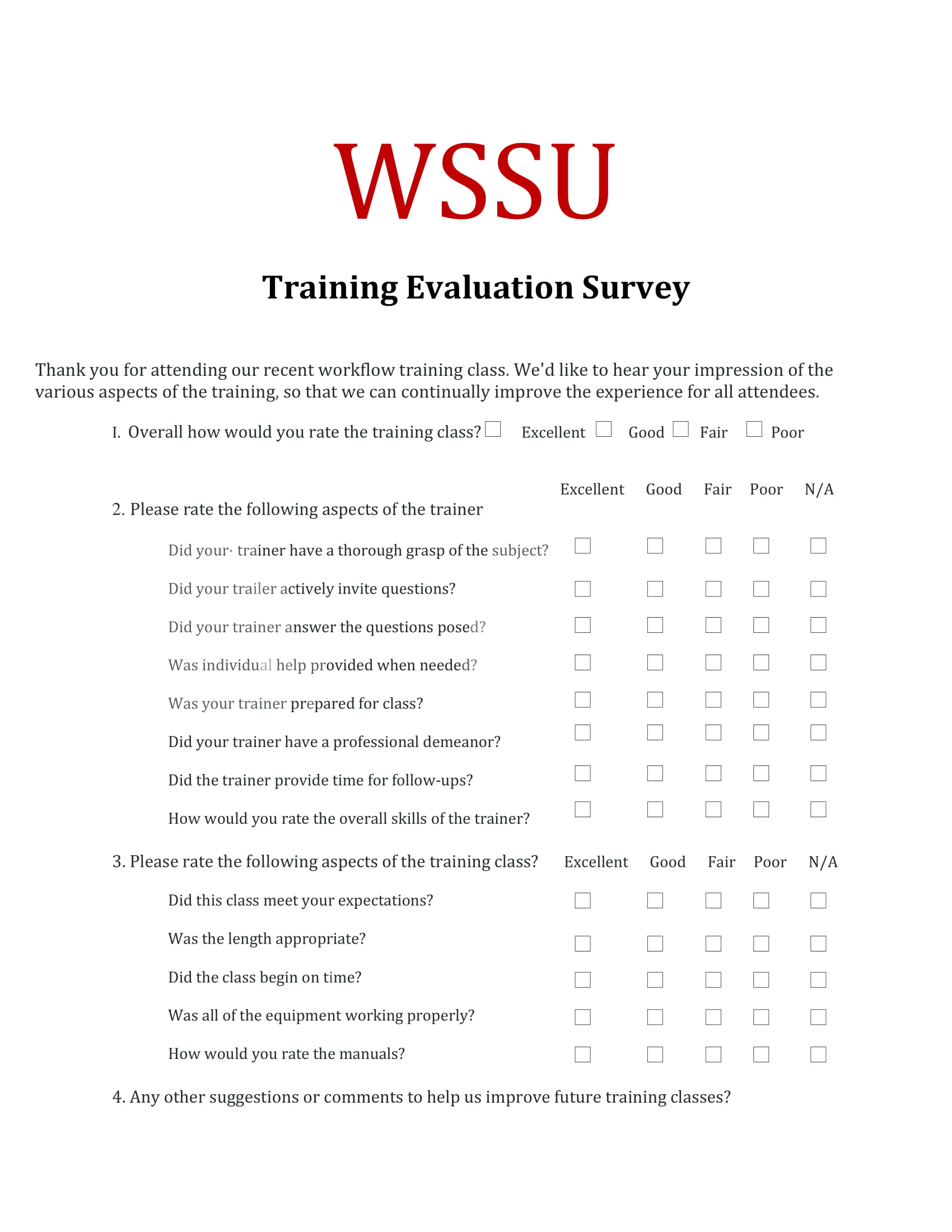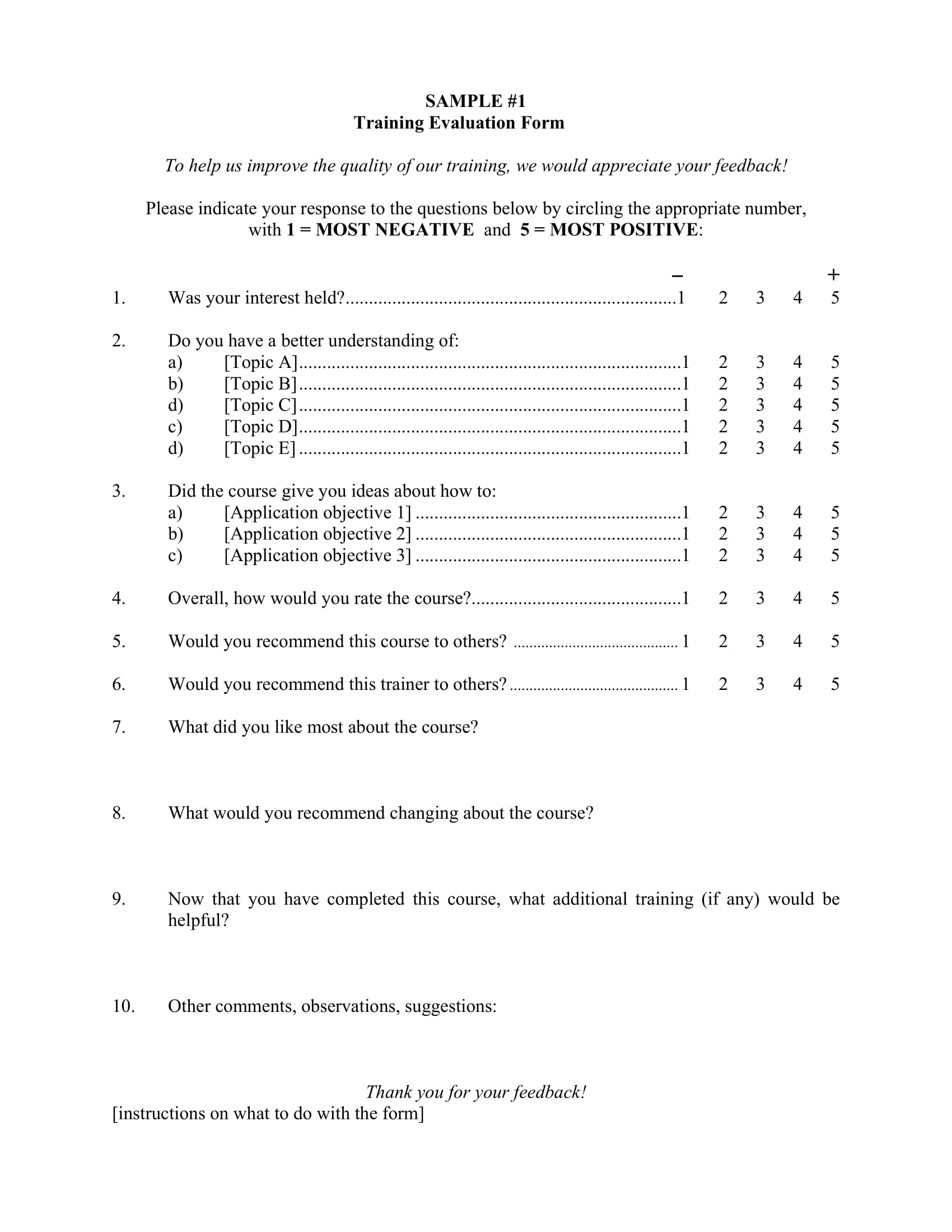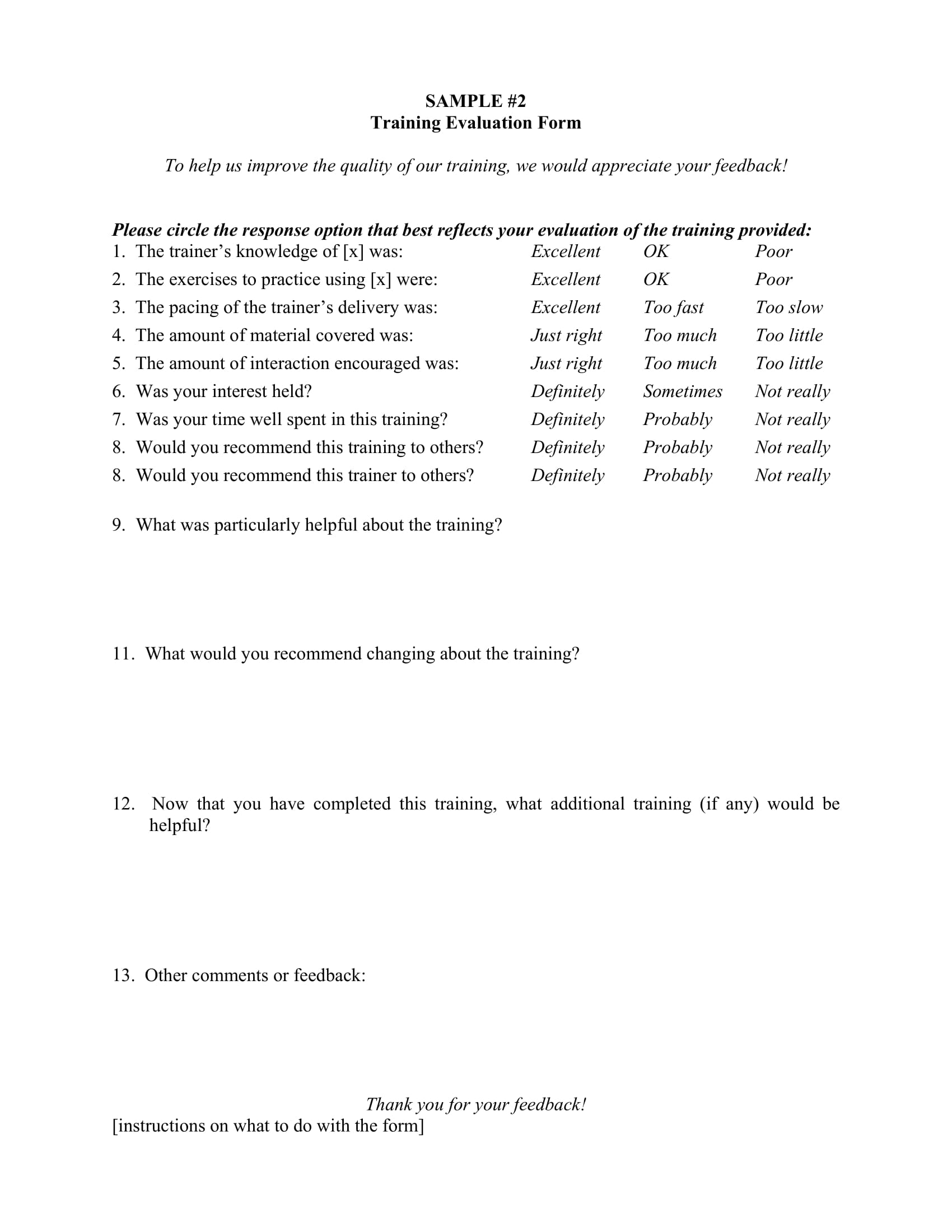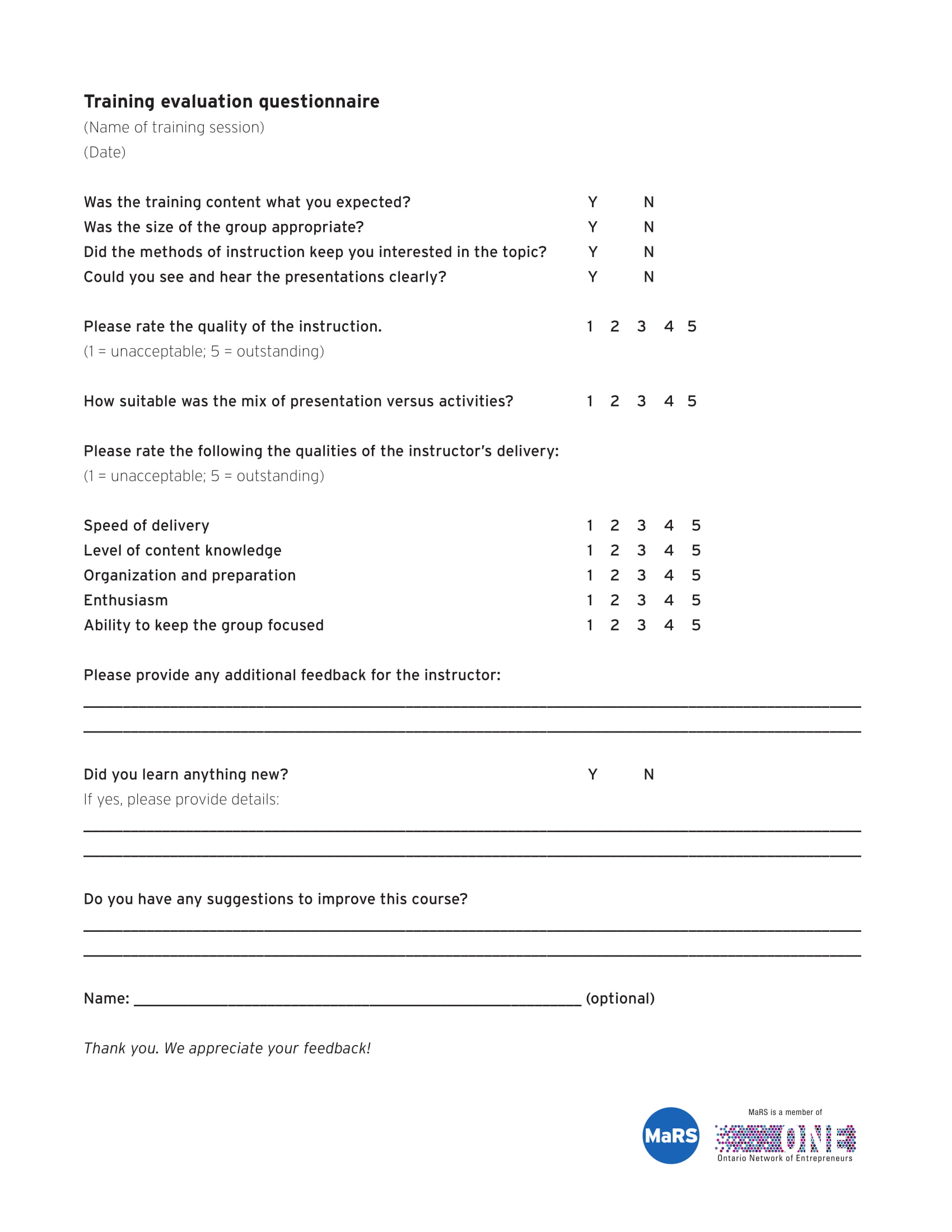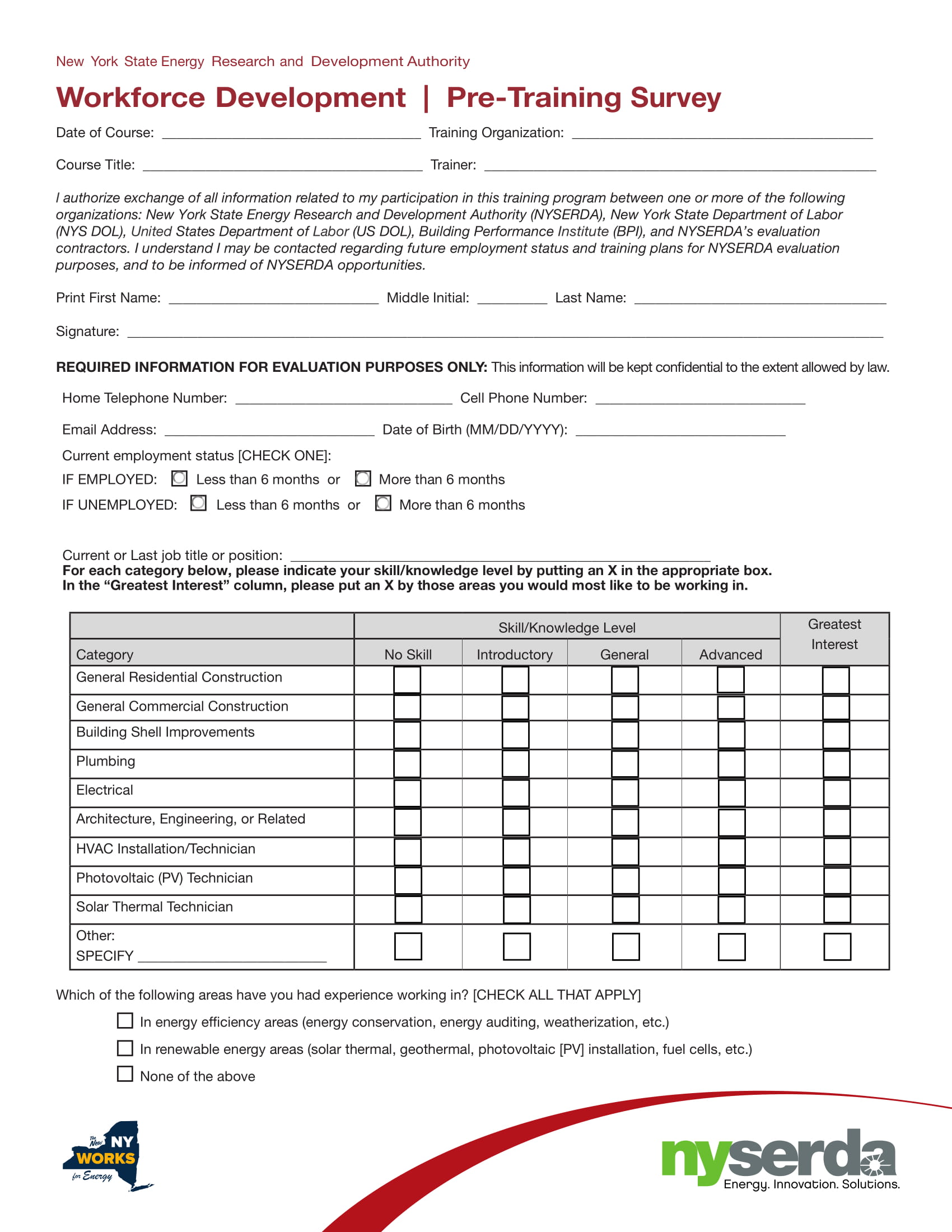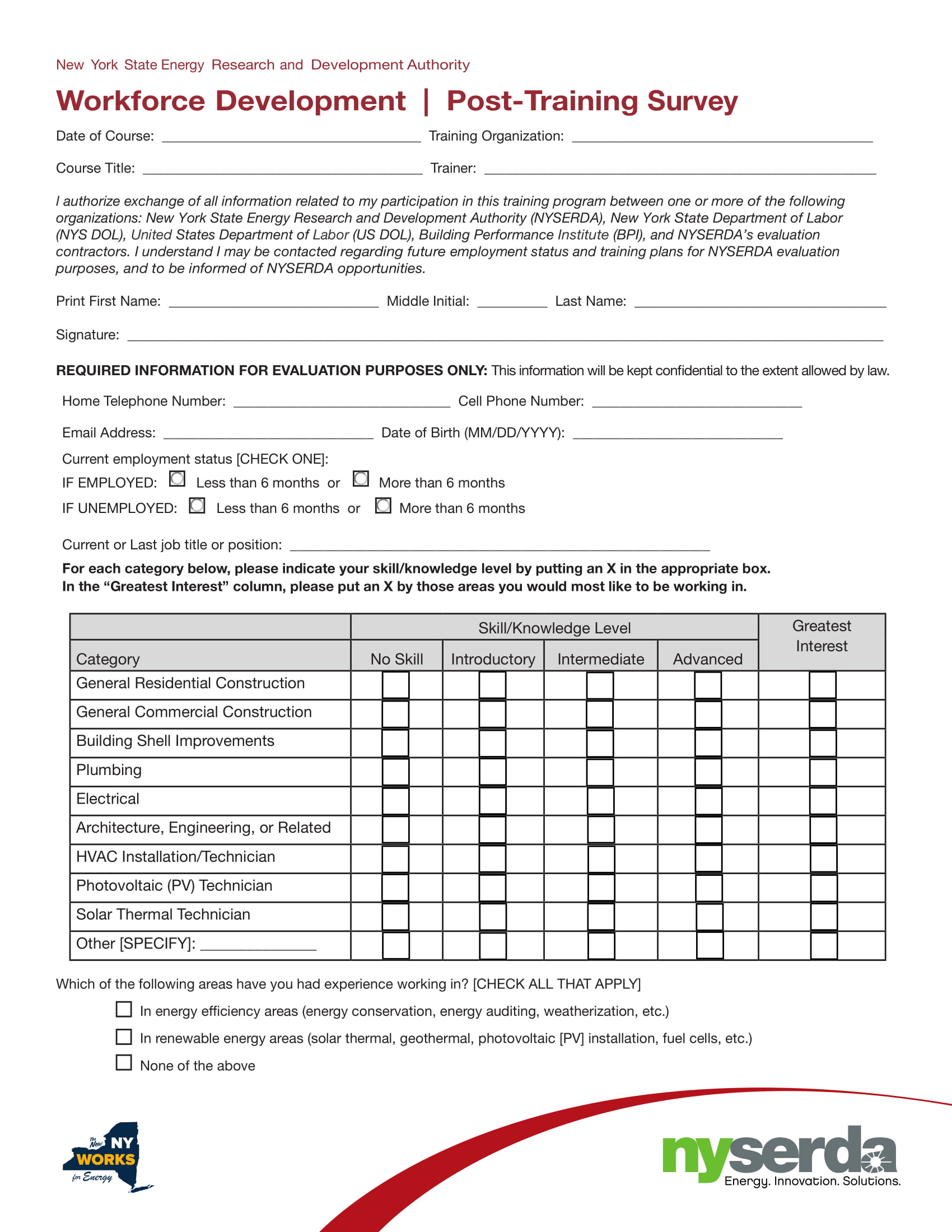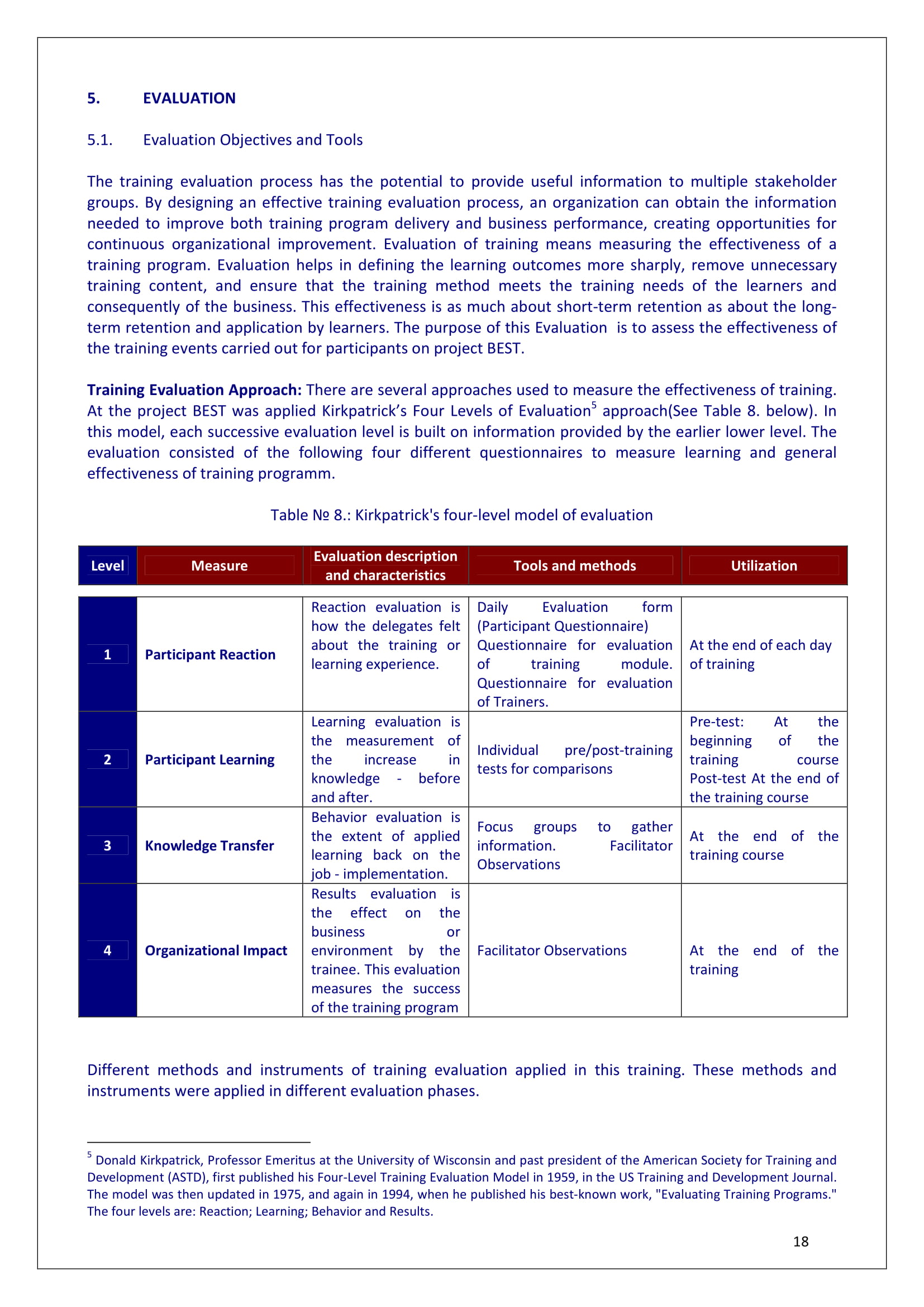9+ Training Evaluation Survey Examples to Download
As they say, development and improvement are good measurements of growth. It can either be about personal growth or professional growth; whatever it is, it’s always good to know that you are developing new sets of skills, characteristics, attitude, etc. in order for you to effectively become a better version of yourself. You may also see what is a survey questionnaire?
Improvement and development comes with tedious work, patience, understanding and the eagerness to further develop yourself. It is not a simple task that is easily achieved after a day of non-stop work, it is a continuous cycle of always trying to be better every single day. In fact, there can be various way to achieve this, too. And perhaps the most common one is through regular training of whatever that interests you the most or on what aspect of yourself you want to improve more. You may also like survey questionnaire examples.
Training Survey Example
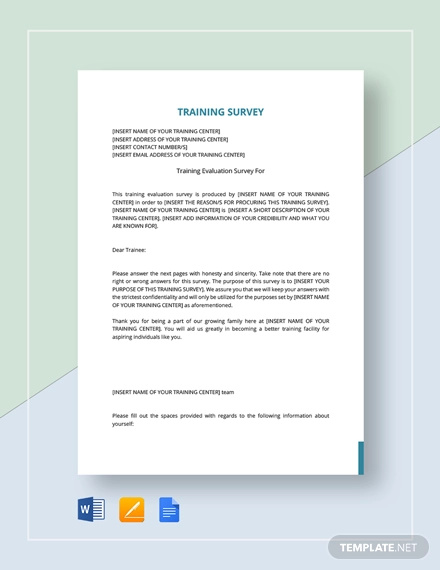
Surveys are important in determining the personal and professional growth of your employees if you are running a business of your own. So, are you on the lookout for a Personal Survey Examples template? Then, checkout this template because it has everything you have been looking for in a survey template. Buy and download this Personal Survey Examples now before it’s too late!
Training Evaluation Manual Example
What is Training Evaluation?
In a working environment, it is common to attend trainings and seminars regarding matters relevant to the job that you currently have. Say for example, your company can conduct online marketing trainings for your marketing department in the hopes that the attendees and employees can construct better online marketing strategies for the company. Same goes for any types of trainings ever conducted. The main goal is always to impart additional or new knowledge to the participants and help them become better at what they do.
But what is done after all these trainings? A training evaluation is assessment of the effectiveness of the conducted trainings. Evaluation in itself is the attempt to get feedback regarding the overall effectiveness of the training and assess the value of the said training in the light of the gathered information.
Training evaluation is applying a set of systematic methods to periodically assess the effectiveness of the conducted training and development programmes. Simply put, it is the step in the training cycle where data is collected to determine if the training program is achieving its objectives. You may also see how to write the perfect survey.
Not only does the survey give you an insight onto the effectiveness of the training, but will also help you understand how well the training was received by the participants. At the end of the, the participants’ feedback about the training you have conducted will be one of the measures to determine how successful it actually is. You may also like health questionnaire examples.
Training Evaluation Field Guide Example
Health Care Survey Examples templates are important because when the patients want to say something about your healthcare service, they can easily express their experiences through surveys. And according to their opinions, you can make new changes to your healthcare service. So, what are you waiting for? Buy this Health Care Survey Examples template now!
Objectives of Training Evaluation
These are the major objectives of evaluating conducted trainings:
- Validate training and development programme as a business tool
- Justify the costs of conducting regular trainings
- To help improve the design and presentation of the organization training and development programme
- To help select effective methods of training and development
You may also see survey questions to ask your customers.
Importance of Training Evaluation
Training evaluation is important because it gives light to these four aspects:
- How well the training program met the learner’s needs and objectives
- What knowledge and skills it has imparted to learners
- What desirable change it has brought in the learners’ performance
- What organizational benefits it has yielded
You may also like how to write a survey questionnaire.
However, some organizations refuse to allot resources in evaluating the effectiveness of their conducted trainings. In this case, organizations will have to face these consequences:
- Lack of skills application
- Inability to measure ROI
- Inability to make contextual training programs in the future
You may also check out marketing research questionnaire examples & samples.
Training Evaluation Form Example
Purpose of Evaluating Training
1. Macro Level
- To assess the business impact of the training and development programme
- To facilitate the selection of metrics performance of the training that is directly related to the organization’s goals and objectives
- To identify the business impact measure through the direct relation of the organization’s goals and objectives.
You may also check out examples of self-administered questionnaire & samples.
2. Micro Level
- To measure the specific business impact of the training and development programme
- To look at the benefit of the specific element of the training to the specific respondent
- To identify the visible link between the specific training business impact and the organization’s goals and objectives
- To combine these purposes to reflect overall business impact
You may also see questionnaire examples in word.
Training Evaluation Survey Form Example
Stages of Training Evaluation
According to the training evaluation model of the Northwest Center for Public Health Practice of the University of Washington, there are five stages that helps set the framework for developing instruments. Each stage corresponds to specific data categories:
- Describe the outputs
- The output from the survey are descriptive data about the training programmes and participants. This includes demographic data. You may also see how to design a marketing survey.
- Pre-training assessment
- This helps uncover past experiences of the participants, as well s present current competencies, learning needs, and expected application of learning
- Post-training assessment (reactions)
- This is relevant to the participants’ reaction to the training experience. This includes their learning environment, format and instructor methods, general satisfaction. You may also like student questionnaire examples.
- Post-training assessment (learning)
- This is the participants’ self-assessment of gained knowledge and/or skills. This also includes the participants’ expected application of learning.
- Follow-up
- This can include several methods in assessing the long-term outcomes and effect of training programs.
The model takes principles from Donald Kirkpatrick’s four-level model, in which evaluation questions fall into the following categories:
- Reaction: How was the training overall? What did participants like and dislike?
- Learning: What knowledge and abilities did participants learn at the training?
- Behavior: How have participants applied the skills they learned?
- Results: What was the effect on the agency or organization?
You may also check out marketing questionnaire examples & samples.
Five Response Option Training Evaluation Survey Form Example
Three Response Option Training Evaluation Survey Form Example
Elements of a Training Evaluation Survey
Since evaluation is a crucial part of determining the effectiveness of both a face-to-face or online training programme, here are the elements you should include in your training evaluation survey questionnaire:
1. Effectiveness
This is the most important element in measuring the performance of the training. It will help the participants establish their perception on whether or not the training has helped them at all. In addition, their input regarding the effectiveness of he training is an indicator on how useful the information imparted during the training and how relevant it is to them. It will help you determine whether the lessons taught and the skills they’ve learned can actually help them in their endeavors. You may also see restaurant questionnaire examples & samples.
You can ask the participants if the training has helped them achieve the objectives they have set before even attending the training and how effective it was in helping them realize their goals. You can also ask them what was the best and worst part of the whole training session and ask to give suggestions on how to improve them.
2. Comprehension
The comprehension in your survey refers to its effectiveness of the course delivery. This means, in your survey ask the participants about how the course content or subject matter was delivered or the manner in which the lesson was facilitated. This also refers to the clarity and conciseness of the discussed content and/or the facilitation of the lessons during the training. You may also like sports questionnaire examples & samples.
You can ask questions like “Was the content easy for the participants to understand?” or “Was the facilitator knowledgeable about the discussed lesson?” or “Was the facilitator able to explain the topic in a way the participants can relate to?”
3. Attractiveness
As shallow as it may seem, but the overall look and feel of the training is an integral part of your training evaluation survey. All the course-related material such as handouts, presentation slides, or multimedia are all under this element. This element can greatly affect your participants learning experience. Therefore, using well-crafted and well-made presentations is very important. In your survey, you can ask participants to rate the printed or multimedia components of the course based on their appeal and clarity. You may also check out questionnaire examples in pdf.
4. Engagement
The engagement in your training refers to the involvement or the participation of the audience in the course discussion. for example, this may refer to active learning approaches like simulations, activities, and collaborative work. This can also be in the form of games, interactive quizzes and branching scenarios. In your survey, you can ask your participants to rate the training based on ow engaging it was for them or how satisfied they were with the interactivity during the training course. You might be interested in how to request a response to a survey or questionnaire.
5. Suggestions
This is also a very significant element of your survey. However, it is also the most challenging one since participants skip this part most of the time. In order to have input on this, require the participants at least three suggestions to improve training effectiveness. And if they don’t fill out this part, warn them that the system will not allow them to proceed to the next step in completing the training course. You may also see research survey examples.
Training Evaluation Questionnaire Example
Pre-Training Evaluation Survey Questionnaire Example
Post-Training Evaluation Survey Questionnaire Example
Five Benefits of Training Evaluation Survey
Training evaluation survey is a great way of getting feedback about the training course you have conducted. Here are five benefits of conducting a training evaluation survey to your participants:
1. Measure participant reaction
Simply put, you want to know the if the participants enjoyed the training, how they felt about the trainer/facilitator, if the training was an appropriate use of their time and most importantly if they felt that he content of the training was relevant to what they do. You may also see travel survey examples.
2. Measure acquired learning and knowledge
The main purpose of conducting trainings is to impart knowledge that participants can acquire, learn and use. A training is ineffective if the participants are not able to gain new knowledge and learn new things.
Your survey will allow you to ask your participants with questions about what they information they can “take home” from the training. Your survey will also allow you to see how much information stays with the participants even after the training ends. You may also like income questionnaire examples & samples.
3. Measure training effectiveness
Your survey will help you measure the effectivity of the training you have conducted through asking questions about behavioral changes in the workplace, and application of the learning they gained during the training. If you want to measure your training’s effectiveness for a couple of times after conducting it, you can conduct a assessment through an online survey.
Through an online survey, you can assess the effectiveness of your training even a month after its completion. This will help you determine long-term effectiveness and sustainability of the training. You may also check out pros and cons of website surveys.
4. Measure training return on investment (ROI)
This can be done two to three months after the completion of the training session. Since you can begin to see the results of the lessons and trainings once it’ put into action, a survey will help you determine if the newly learned knowledge and skills are practically used in the workplace. Through the survey you can measure the changes in the organization such as productivity, results, efficiency, etc. compared to the cost of implementing the training. You might be interested in job satisfaction survey examples.
5. Measure impact to business/business improvement
To help determine if there has been an overall improvement in productivity, morale, and engagement in the whole company, ask questions about the performance, complaints, turnovers, non-compliance, and other issues. These questions should be asked in a survey for the managers, team leaders, supervisors, and human resource personnel. You may also see examples on how to conduct a business survey.
Training Evaluation Survey Final Report Example
Contents to Include in a Training Evaluation Survey
There can be various questions you can ask during your training evaluation survey, but here re the most important and effective questions you need to ask:
1. Costumer satisfaction
You need to ask outcome questions in your survey first. This means asking questions whether or not the participants were satisfied with the training and were they able to achieve their objectives. This will help you how happy were the participants about the overall training.
This question will also help tell you costumer/participant loyalty in the future. You can ask a question like this: “How likely would you be to recommend this training course to a friend or colleague?” You may also see hotel/restaurant survey examples.
2. Is the content what was promised?
As the person or organization in charge of conducting trainings, you will need to engage participants in order to gain costumer loyalty. In trainings, you should be able to deliver what you promise to give. You need to understand and determine if the participants felt that they were not shorthanded with the topics you have discussed in your training. Ask them if the content that was delivered matched what was promised during you registration. You may also like training survey examples.
3. Did you learn something new?
Of course, as the main goal of conducting training, you must be able to impact new knowledge and skills the participants can gain and use in their respective careers. You need to understand if the information you have imparted are new to the participants or not in order to know the true value of the training course.
Asking them a question like this “How much new information did you receive in the training course?” will help you evaluate this aspect. You may also check out examples of writing a conference feedback survey.
4. How usable is the information?
Participants attend trainings in the hopes of learning something new and useful. They don’t pay registration fees just to spend time with friends and eat snacks, they want to learn something and take knowledge from the training.
Although you think that the information in your training is important, it should also be actionable and useful to them. Ask the participants is the information you have shared can help them with their daily work. For example, “How actionable was the information you received in the training?” You might be interested in how to create and conduct a b2b customer survey.
5. Presenter rating
The participants’ perception of the course will be heavily influenced by how the presenter delivered the course content during the training especially if it’s a single presenter training course. You need to know and understand if the presenter effectively delivered his/her content during the training.
However, it may be hard to make the participants answer this kind of question, the most effective question when asking for a rating is with this question, “How engaging was the main presenter?” You may also see examples of writing a brand awareness survey.
Tips in Creating Training Evaluation Survey
1. Keep the evaluation short
There is no need to make a lengthy survey that will yield less data and results. It should not more than one page and has to only take five minutes to complete. You may also see customer service questionnaire examples & samples.
2. Ask questions related to the objectives of the training
Ask questions whether they understood the delivered content and if they can use and apply the content in their life and/or careers.
3. Only ask about things you could and would change
There is no point in wasting the participants’ time in asking questions you couldn’t and wouldn’t change. Aside form measuring the training’s effectiveness is to know what you need to change and improve. For example, these aspects can easily be improved different sequencing of material, different length of session, different venue. You may also like what is the importance of a questionnaire?
4. Use “close-ended” questions
These questions are the easiest and the quickest ones to complete, thus, the easiest to have more gathered data. These questions ares where they choose from response options.
5. Give more response options
For close ended questions, give at least three and at most five response options the participants can choose from. Giving only two options will trigger judgmental mindset instead of an evaluative one; giving more than five options will confuse them and will give you poor quality data. You may also check out product questionnaire examples & samples.
6. Include a question about the action they are willing to take
This means asking them if they are willing to recommend the training or if they are willing to attend a similar training that you will conduct in the future. This can also be the best way to measure their satisfaction with the training.
7. Ask one “open-ended” question
Include at least one open-ended question in your survey. This will allow you to gather specific feedback from your participants.
8. Make evaluation the last part of the training
Give the participants sufficient time to answer the survey after you have formally concluded the training course. This way you are not using their own time to help you gather your needed data. You might be interested in examples of questionnaire for customer satisfaction.
9. Explain that you want their honest feedback
During the distribution of your survey form, make sure the participants understand that you want their honest answers and feedback. This will help you you know what to keep the same and what to improve in order to provide a more effective training.
10. Make sure that the evaluation forms are anonymous
Provide assurance regarding the anonymity of the participants in the survey, this will help the participants provide honest answers without the fear of hurting your feelings. This can be through anonymously submitting their survey forms like putting them in a box, putting them face down on a table, submitting them online without their return email address being visible. You may also check out hr questionnaire examples & samples.

In conclusion, training evaluation in itself is a great way of gathering feedback from the training participants. It can help measure the effectiveness of the whole training, the outputs and methods used in delivering the promised content. This also helps you understand if the knowledge you have shared during the sessions are relevant useful for the participants. You may also see examples of online questionnaire.
The training evaluation survey is a helpful tool in gaining the usable information regarding the training. It helps you have a clear insight about the reactions and perception of the participants about the training. Aside from that, the survey helps you gather not only good quality data but also quantifiable and usable data for improving your training content and delivery. You may also like customer satisfaction survey examples.



